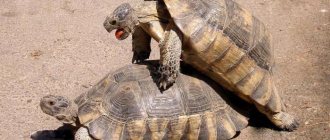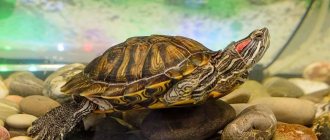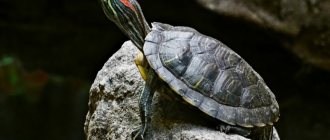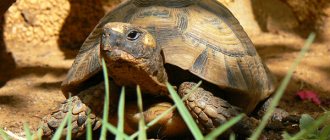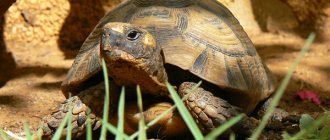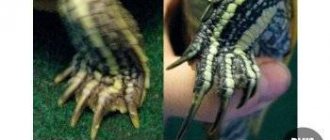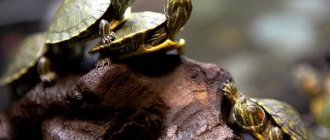- Wild animals
- >>
- Reptiles
The red-eared slider is the most popular pet amphibian in the world, which is why it became the best-selling turtle at the end of the 20th century. This species is native to the southern United States and northern Mexico. However, it gradually began to spread to other regions due to people refusing to keep it as a pet and throwing it into local water bodies.
Invasion and occupation of territories caused by careless human activities has led to problems with the fauna of many countries, as the red-eared slider displaces native species. The ruby is included in the list published by the IUCN of the 100 most invasive species.
Origin of the species and description
Photo: Red-eared turtle
Fossils indicate that turtles first appeared on earth about 200 million years ago, during the Upper Triassic period. The first known turtle was Proganochelys quenstedli. It had a fully developed shell, skull-like skull and beak. But, Proganochelys had several primitive features that modern turtles do not have.
By the mid-Jurassic period, turtles had split into two main groups: those with arched necks (pleurodire) and those with side necks (cryptodires). Modern side-necked turtles are found only in the southern hemisphere and move their heads to the side under the shell. Arch-neck turtles retract their heads in an S shape. Scutemy was one of the first arch-neck turtles.
Video: Red-eared slider
The red-eared or yellow-bellied turtle (Trachemys scripta) is a freshwater turtle belonging to the family Emydidae. It gets its name from the small red stripe around its ears and its ability to quickly glide off rocks and logs into the water. This species was previously known as Trost's turtle after American herpetologist Gerard Trost. Trachemys scripta troostii is now the scientific name of another subspecies, the Cumberland turtle.
The redfish belongs to the order Testudines, which contains about 250 species.
The species Trachemys scripta itself contains three subspecies:
- Ts elegans (red-eared);
- T.s. Scripta (yellow-bellied);
- Ts troostii (Cumberland).
The first known literary mention of redears dates back to 1553. When P. Cieza de Leone described them in the book “Chronicles of Peru”.
Habitat of red-eared turtles in nature
In nature, the red-eared turtle lives in small lakes, ponds and other bodies of water with low, swampy shores.
Leads a relatively sedentary lifestyle. Extremely curious about everything that happens around. If the turtle is full, it crawls ashore and basks in the sun. And if she gets hungry, she swims in search of food.
When the water temperature is below +18 °C, the turtle becomes lethargic and loses its appetite. We can say that such a temperature already poses a danger to her life. The turtle is able to notice danger at a distance of 30-40 m, after which it slides into the water with lightning speed (for which it received the nickname “Slider”).
Appearance and features
Photo: Animal red-eared turtle
The length of the shell of this type of turtle can reach 40 cm, but the average length ranges from 12.5 to 28 cm. Females are usually larger than males. Their shell is divided into two sections: the upper or dorsal carapace (carapace) + the lower, abdominal (plastron).
The upper shell consists of:
- vertebral shields, which form the central elevated part;
- pleural shields located around the vertebral shields;
- edge shields.
The scutes are bony keratin elements. The carapace is oval and flattened (especially in men). The color of the shell changes depending on the age of the turtle. The carapace usually has a dark green background with light or dark markings. In young or newly hatched specimens, this is the color of the green foliage, which gradually darkens in mature specimens. Until it turns dark green and then changes shade between brown and olive green.
The plastron is always light yellow with dark, paired, irregular markings in the center of the shields. The head, legs and tail are green with thin, irregularly shaped yellow lines. The entire shell is covered with stripes and markings that help in camouflage.
Interesting fact! The animal is a poikilotherm, that is, it cannot independently regulate its body temperature and is completely dependent on the temperature of the environment. For this reason, they need to sunbathe frequently to stay warm and maintain their body temperature.
Turtles have a complete skeletal system with partially webbed feet that help them swim. The red stripe on each side of the head distinguished the red-eared slider from other species and became part of the name, as the stripe is located behind the eyes where their (outer) ears would be.
These stripes may lose their color over time. Some individuals may have a small marking of the same color on the top of the head. In addition, they do not have a visible outer ear or external auditory canal. Instead, there is a middle ear, completely covered with a cartilaginous tympanic disc.
Where does the red-eared turtle live?
Photo: Little red-eared turtle
Habitats are in the Mississippi River and Gulf of Mexico, as well as in the warm climate of the southeastern United States. Their home territories range from southeastern Colorado to Virginia and Florida. In the wild, red-eared turtles inhabit areas with sources of calm, warm water: ponds, lakes, swamps, streams and slow-moving rivers.
They live where they can easily get out of the water, climb onto rocks or tree trunks to warm themselves in the sun. They often sunbathe in a group or even on each other. These turtles in the wild always stay close to water unless they are searching for new habitat or laying eggs.
Due to their popularity as pets, red whales have been released or escaped into the wild in many parts of the world. Wild populations are now found in Australia, Europe, Great Britain, South Africa, the Caribbean, Israel, Bahrain, the Mariana Islands, Guam, and Southeast and Far East Asia.
An invasive species has a negative impact on the ecosystems it occupies because it has certain advantages over native inhabitants, such as a lower age at maturity and higher fertility rates. They transmit diseases and displace other turtle species with which they compete for food and breeding space.
Diet of the red-eared slider
These turtles are unpretentious in their diet. They eat almost everything. Therefore, to the question of what to feed the red-eared turtle, there is only one answer - everything.
Many people avoid artificial food and do it in vain. They contain all the elements necessary for the full development of a pet.
In addition, vitamin components and concentrated protein substances added to them make care easier. But in addition to this food option, fresh vegetables must be included.
With proper care and proper nutrition, a red-eared turtle at home will delight its owners for a long time.
But before purchasing, make sure that you are able to provide delicate care for this exotic animal.
What does the red-eared slider eat?
Photo: Red-eared turtle boy
The red-eared slider has an omnivorous diet. They need abundant aquatic vegetation, as this is the main food of adults. Turtles do not have teeth, but instead have jagged and sharp horny ridges on their upper and lower jaws.
The animal's menu includes:
- aquatic insects;
- worms;
- crickets;
- snails;
- small fish,
- frog eggs,
- tadpoles,
- water snakes,
- various algae.
Adults tend to be more herbivorous than juveniles. When young, the red-eared turtle is a predator, feeding on insects, worms, tadpoles, small fish and even carrion. Adults are more inclined to a vegetarian diet, but do not refuse meat if they can get it.
Interesting fact! Sex in turtles is determined during the embryogenesis phase and depends on the incubation temperature. These reptiles lack sex chromosomes that determine sex. Eggs that are incubated at 22 - 27°C become only males, and eggs that are incubated at higher temperatures become females.
These reptiles are highly adaptable to their environment and can adapt to anything from brackish waters to man-made canals and urban ponds. The red-eared slider can wander away from water and survive cold winters. Once available habitat is found, the species quickly colonizes the new area.
Description
In adult individuals, the shell is dotted with many wrinkles. The average size of red-eared turtles depends on the species, some representatives reach a length of 28 cm. A specific feature of these reptiles is the presence of a small spot in the eye area.
Another property that owners of these pets pay attention to is their ability to change color. Although they cannot transform instantly like chameleons, turtles gradually adapt to their environment over the years. So, a young individual has a green color, but in old age it turns black. The ventral shell of turtles is bright yellow, with dark round spots.
Yellow-bellied reptiles grow unusually: in the first 18 months their size increases to 7.5 cm, then the growth rate slows down, and each year the turtle becomes larger by only 12.5 mm. As a result, the pet grows to 20 cm or more, so all the sellers’ assurances that the breed is dwarf turn out to be a deception.
Features of character and lifestyle
Photo: Large red-eared turtle
Red-eared turtles live from 20 to 30 years, but can live more than 40 years. The quality of their habitat has a strong influence on life expectancy and well-being. Turtles spend almost all their time in the water, but since they are cold-blooded reptiles, they leave the water to sunbathe in order to regulate their body temperature. They absorb heat more efficiently when their limbs are extended outward.
Red whales do not hibernate, but plunge into a kind of suspended animation. When turtles become less active, they sometimes come to the surface for food or air. In the wild, turtles spend the winter at the bottom of ponds or shallow lakes. They generally become inactive in October when temperatures drop below 10°C.
During this time, turtles enter a state of stupor, during which they do not eat or defecate, remain almost motionless, and their breathing rate drops. Individuals are most often found underwater, but have also been found under rocks, in hollow stumps and sloping banks. In warmer climates, they can become active in winter and come to the surface to swim. When the temperature begins to drop, they quickly return to a state of stupor.
On a note! Red-eared turtles are caught for food from early March to late April.
During brumation, the species can survive anaerobically (without air) for several weeks. The turtles' metabolic rate drops sharply during this time, and heart rate and cardiac output are reduced by 80% to minimize energy requirements.
Social structure and reproduction
Photo: Red-eared turtle
Male turtles reach sexual maturity when their shell is 10 cm in diameter, and female turtles are mature when their shell is 15 cm in diameter. Both males and females are ready to reproduce at the age of five to six years. The male is smaller than the female, although this parameter is sometimes difficult to apply since the individuals being compared may be of different ages.
Courtship and mating take place underwater from March to July. During courtship, the male swims around the female, directing his pheromones towards her. The female begins to swim towards the male and, if she is receptive, sinks to the bottom to mate. Courtship lasts about 45 minutes, but mating takes only 10 minutes.
The female lays between two and 30 eggs depending on body size and other factors. Moreover, one individual can lay up to five clutches in one year, with time intervals of 12-36 days.
Interesting fact! Fertilization of the egg occurs during oviposition. This process allows fertilized eggs to be laid in the next season, since the sperm remains viable and available in the female’s body even in the absence of mating.
In the last weeks of pregnancy, the female spends less time in the water and looks for a suitable place to lay eggs. She digs a hole-nest using her hind legs.
Incubation takes from 59 to 112 days. The offspring remain inside the eggshell for two days after hatching. During the first days, the cubs still feed from the yolk sac, the reserve of which still remains in the egg. The area through which the yolk is absorbed must heal on its own before the turtles can swim. The time between hatching and immersion in water is 21 days.
Natural enemies of the red-eared slider
Photo: Adult red-eared turtle
Due to its size, bite and thickness of shell, an adult red-eared turtle should not be afraid of predators, of course, unless there are alligators or crocodiles nearby. She can retract her head and limbs into her shell when threatened. In addition, red whales monitor predators and seek refuge in the water at the first sign of danger.
However, this does not apply to juveniles, which are preyed upon by a variety of predators, including:
- raccoons;
- skunks;
- foxes;
- wading birds;
- storks.
Raccoon, skunk and fox also steal eggs from this turtle species. Juveniles have unusual defenses against predatory fish. When swallowed whole, they hold their breath and chew the mucous membrane inside the fish until the fish regurgitates them. The bright colors of small predators warn large fish to avoid them.
In their home range, red-eared turtles occupy an important ecological niche both as food and as a predator. Outside their habitats, they fill the same types of niches and become an important food source for predators in urban and suburban areas.
Due to their adaptability, red-eared turtles are the predominant turtle species in urban environments. Most parks in many cities in the United States have thriving colonies of red-eared turtles for people to enjoy.
Pond slider
On the southern coast of Crimea, the North American red-eared turtle began to be recorded more and more often. Outside the Gulf Coast (eastern United States, Mexico, and northern South America), this species is most often kept in captivity. But many owners, unable to cope with caring for their animals, release their pets into nature. As a result, Trachemys scripta becomes an invasive species.
Where else are red-eared turtles found in Russia? Until recently, scientists believed that encounters with representatives of this species were random. However, they are increasingly being recorded in ponds in Moscow and the Moscow region. The climatic zone of the southern European part of the country is quite suitable for Trachemys scripta elegants and other subspecies, which can cause harm to existing ecosystems.

